SEPTEMBER+OCTOBER 2020
How to be a nicer driver
What new car tech can (and can’t) do
Getting ready for your first RV trip


SEPTEMBER+OCTOBER 2020
How to be a nicer driver
What new car tech can (and can’t) do
Getting ready for your first RV trip

Your favorite hikes and a Sonoma Coast road trip






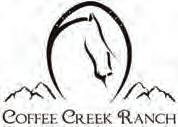
EDITOR IN CHIEF Dan Miller
MANAGING EDITOR Whitney Phaneuf
CONTRIBUTING EDITORS Avital Andrews, Katie Henry, Rebecca Smith Hurd
DESIGN DIRECTOR Monica Ewing Jensen
PRODUCTION DIRECTOR Amy Mackey
ASSOCIATE ART DIRECTOR Veronica Sooley
PHOTO EDITOR Maggie Perkins
EXECUTIVE DIGITAL PRODUCER Rebecca Harper
DIGITAL MARKETING STRATEGIST Valerie St. John
SOCIAL MEDIA Arthur Ilasco
ADVERTISING LEAD Linda Black
ACCOUNT EXECUTIVES Bruce Colton, Kevin McCaw, Mike Walker
ADVERTISING COORDINATOR Natasha Alcalá
ADVERTISING ACCOUNTING William Nocera

2,292,809 COPIES Subscription rate: AAA primary members, $2 (included in dues). Change of address: Allow four weeks’ advance notice. Contact AAA at (800) 922-8228. Manuscripts and photos: Query first; Via assumes no responsibility for return of unsolicited material. Reprints from Via: Contents copyrighted 2020 AAA Northern California, Nevada & Utah. No part of Via may be reprinted without written permission. Contact Via Editorial: Address all mail to Via, AAA, P.O. Box 24502, Oakland, CA 94623, or viamail@via magazine.com. Contact Via Advertising: Address all mail to Via Advertising, AAA, P.O. Box 24502, Oakland, CA 94623. Fax (510) 899-0525.
Via (ISSN 1093-1716) is published four times a year, in March, May, September, and November by AAA Northern California, Nevada & Utah, 1277 Treat Blvd., Suite 1000, Walnut Creek, CA 94597. Periodicals Postage: Paid at Walnut Creek, CA, and at additional mailing offices. Postmaster: Send address changes to Via AAA, P.O. Box 24512, Oakland, CA 94623.
Dispersed camping in an RV will have you effortlessly enjoying the views in no time. Page 42.

32 Help on the Way
Advanced Driver Assistance
Systems are changing the way we drive. Here’s what these increasingly common technologies can—and can’t—do. by josh sens
38 Sonoma Coast Ramble
When the fog lifts and the crowds leave, the winding road to Northern California’s seaside hamlets beckons. by josh sens
42 A Beginner’s Guide to RVs
Prepare for an epic road trip with expert advice, from how to drive an RV to finding the best spots to slumber under the stars.
by laura kiniry
4 To Our Members
Now more than ever, AAA remains committed to helping our Members and communities.
6 A AA Insider
Save money while on the road.
8 Community
GIG Car Share supports nonprofits in their community missions with free car access.
11 Smart Life
Safe fall adventures, precautions to take on your next road trip, and the best smart devices for your home.
16 On the Road
Favorite hikes around the West; Mount Diablo’s stunning views and epic trails; highdesert hoodoos in Cedar Breaks.
25 Smart Guide
Make the road more civilized and less hazardous with these 16 tips.
48 #ViaAdventure
Staying close to home reveals neighborhood treasures for this San Francisco Member.
ON THE COVER
Perched on a bluff above the roaring Pacific, Timber Cove Resort in Jenner, Calif., offers a peaceful respite from a day of exploring along the Sonoma Coast—and a perfect spot to catch the sunset. Page 38.
Cover photograph by David H. Collier

Hello, my fellow AAA Members.
As I write to you, here in late August, the country is still in the midst of the Covid-19 pandemic, a momentous national election is coming up, and a host of complex social issues remains stubbornly unresolved. To say that these are unprecedented, uncertain times is putting it very mildly.
Here at AAA, we obviously don’t have the answers or solutions to these issues. Yes, we have perspectives and insights about them, which we share with our employees, so that collectively we can take action when and where it’s possible. But one thing we can say: Now more than ever, we remain committed to helping our Members and communities navigate the obstacles ahead.
Everyone is looking to find ways to stay safe these days while maintaining some level of normalcy. For the vast majority of our Members, just knowing that our superior roadside assistance and battery replacement services are there for them can provide a little extra peace of mind in these troubling times. As more of you venture forth on weekend (or longer) road trips, remember that our services are available 24/7, nearly anywhere you roam nationwide.
We’re using this time to make meaningful updates to the products and services we offer. Take, for example, our home security offering from AAA Smart Home. In addition to the professional in-home installation services we offer in California and Arizona, we’ve also launched new self-install bundled solutions that provide the same premium products and Member value—now available for purchase from our branches.
I would be remiss if I didn’t mention that there are hundreds of ways you can save money by being a Member of AAA. For example, bundling auto and home insurance coverage plans can save you hundreds of dollars; adding home security can lower your rates even more. These are substantial reductions that can make a significant difference to your household budget.
As we embrace the coming of fall, please stay safe and healthy as we all journey this road of life together. ba.
Connect with us
Instagram .com/aaa_via AAA.com/ facebook
AAA.com/ twitter
TIM CONDON, PRESIDENT & CEO
Share your thoughts
Send comments, tips, or questions to viamail@via magazine.com or Via, AAA, P.O. Box 24502, Oakland, CA 94623. Your input may be edited and published in print or online.
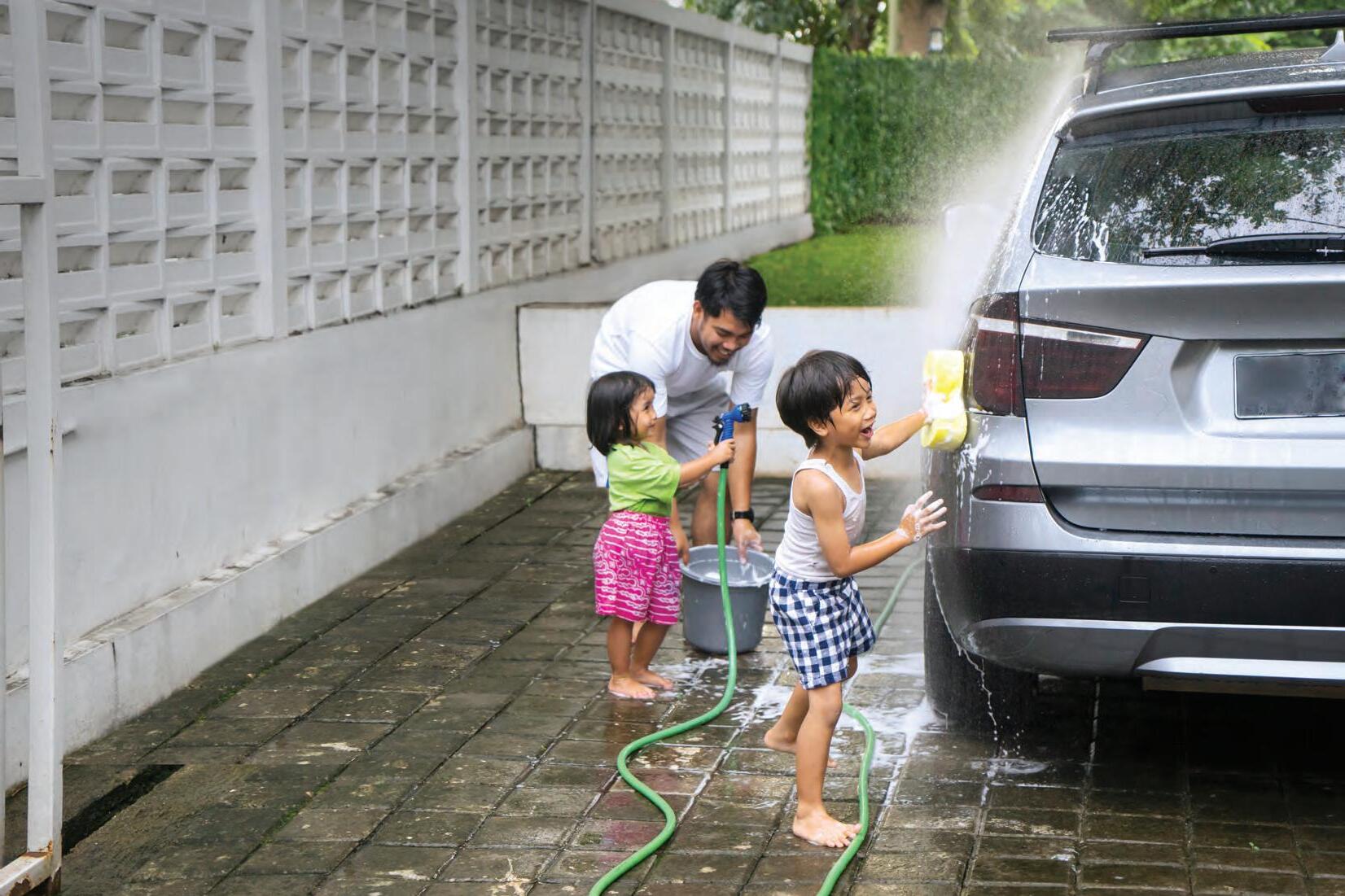

For road trips that require an overnight stay, look for hotels with the AAA Diamond designation and available discounts. You can trust that every AAA Diamond property offers a clean and comfortable experience because these designations are awarded only to properties that pass a rigorous, in-person inspection.
↘ AAA.com/hotels

Get your vehicle roadtrip ready with a tune-up from our ASE certified technicians at a nearby AAA Approved Auto Repair shop. All AAAapproved facilities undergo an inspection process and offer fair pricing, quality of work guarantees, priority service, highly trained staff, and discounted labor.
↘ AAA.com/autorepair
How to save money on your next road trip.
Travel restrictions and social distancing may have put your vacation plans on hold, but when public health officials say it’s safe to venture out again and you’re ready, roadtripping will be a great option to avoid crowds. AAA and its travel partners can help you save money on your next family journey—from the first mile to the last.

AAA members who enroll in Fuel Rewards at Shell can save at least 5 cents per gallon every time they fill up, with no minimum purchase required. Once you’ve registered online, enter your phone number at the gas pump or in-store before filling up to apply the discount.
↘ AAA.com/shell

Research your next trip using the online AAA Travel Guides.
↘ AAA.com/travel guides
TRIPTIK
Map your route with the AAA TripTik Travel Planner, a smartphone app that provides pointto-point directions, and features AAA-approved hotels and restaurants. TripTik even shows you the best fuel prices along your route!
↘ AAA.com/triptik
ROAD TRIP IDEAS
Browse the selection of road trips by region.
↘ AAA.com/roadtrips













If you’ve followed the adventures of Mickey Mouse and his leading lady, Minnie Mouse, they have surely captured your heart. Now, of cially licensed artistry of this Disney duo adds designer style to your wardrobe. Crafted of soft, pebbled faux leather in a chic color block combination of cream, gray, black and red, our “Mickey & Minnie Love Story” Handbag is an enchanting must-have!
On the front of the bag is vintage-style artwork of Mickey Mouse and Minnie Mouse depicting their love-at- rst-sight romance. The story continues with a portrait on the back that features the two sweethearts sharing a kiss. A locket-style heart charm with a Mickey Mouse silhouette with faux jewels adds an extra designer touch. Double red handles as well as a 60" removable, adjustable cross-body strap create an accessory that is as functional as it is fashionable. A zippered main compartment, interior accessory pockets and metal feet complete the design.







This custom fashion essential featuring Disney art is just $129.99*, payable in 4 easy installments of $32.49 each. To order yours, backed by our 90-day moneyback guarantee, send no money now. Just return the Priority Reservation. Remember, you won’t nd this design in stores—so don’t be disappointed, order today!






GIG Car Share helps nonprofits do their work.
It’s been a busy year for the Food Bank of Contra Costa and Solano. Between the coronavirus pandemic and the resulting financial crisis, its services— distributing food to multiple sites in Northern California—have never been needed more. AAA has been there to help with its Gig4Good program.
GIG Car Share debuted in the San Francisco Bay Area in 2017. AAA expanded the service to Sacramento in 2019 and to Seattle in 2020. Gig allows you to quickly and easily rent a vehicle through a smartphone app. Gig4Good extends that service to qualified nonprofits, providing cars at no cost for up to a week at a time. (Vehicles in the program are deep-cleaned before and after every use, as an extra precaution.)
“We started Gig4Good as a way to help community-focused organizations perform mission-critical tasks like delivering food during the pandemic,” says Jason Haight, president of GIG Car Share, “but have now expanded it to support a wide variety of community services.”
“The use of these vehicles from Gig could not come at a better time,” says Joel Sjostrom, president and CEO of the food bank.
His organization is just one of 10 nonprofits that have taken advantage of Gig4Good to date. The others are: Clausen House (Oakland); Feed Sacramento Homeless (Sacramento); Lifelong (Seattle); Meals on Wheels of Alameda County (San Francisco Bay Area); Open Arms Perinatal Services (Seattle); Rose Family Creative Empowerment Center (Sacramento); Saint John’s Program for Real Change (Sacramento); Solidarity of Unhoused People (Sacramento); and Stanford Settlement (Sacramento).

American Gold Reserve is releasing Government issued $5 Gold American Eagles completely free of dealer mark up for only $189 each. These beautiful $5 Gold American Eagles are a perfect way to enter the gold market. They are set for immediate public release and will sell out fast.
If you had $25,000 in gold in 2001, you would have over $125,000 with today’s gold prices. This may be your last chance to own these magnificent gold pieces. Order now!
Due to extremely limited supplies we must adhere to a strict limit of ten coins per household.









SMART LIST
5 things to do this fall
Whetheryou’re staying home or going out, safe adventures await.
Transform your backyard. Create an escape at home by turning your yard into a fun zone. Set up classic outdoor games such as bocce, croquet, and corn hole, hold movie nights, and pitch a tent for the kids to play in (or sleep in, weather permitting).
Go apple picking. Northern California has many varieties of apples you can pick right off the branch, from Mollie’s Delicious to Honeycrisp. To find farms and orchards throughout the state, visit pickyourown.org/CA.htm.
5 4 3 2 1
Watch a movie at the drive-in. Drive-in theaters had been on the brink of extinction, but with social distancing guidelines in place, the outdoor screens are experiencing a resurgence. Discover drive-ins throughout the West at AAA.com/drive-in. In addition, Walmart is
showing films in its parking lots this fall. For more information, visit walmart drive-in.com.
Clean out your closets. Being home means more time to assess clutter. Start with your closet, organizing clothes by category (pants, coats, etc.). From there, separate them into “donate” and “keep” piles, holding on to only the items you love to wear. Most nonprofits have returned to accepting donations, but call ahead as some are now open by appointment only.
Join a virtual book club. Diving into a good book reduces stress, and a virtual club lets you connect with fellow readers. Start a group with your friends or join one at goodreads .com/group, where you’ll find book clubs led by Oprah Winfrey and Reese Witherspoon.

Going on a long drive? Here are 6 ways to stay safe.
Although health concerns have put a crimp on travel plans for the foreseeable future, many of us still need to go on overnight or multiday car trips. In the wake of Covid-19, such trips— whether for work or for personal reasons—are no longer a matter of casually throwing a bag in the back seat and hitting the road. These days, they require an extra degree of preparation and precaution. Here’s how to make your next long drive a safe one.
1 Get informed. Before you go, check the CDC’s Covid-19 tracker (cdc.gov/covid-data-tracker). Stay abreast of local health advisories and mandates, and keep up on news for every place you plan to visit.
2
Prepare your vehicle. If you’ve been using your car less frequently lately, make sure it’s ready to go before you leave. Monitor tire pressure and oil and coolant levels and get the battery checked.
3
Pack smart. In addition to the emergency supplies that you should always keep in your car (such as water, a first-aid kit, and an emergency supply of prescription medicines), you should also pack dis i nfectant wipes, hand sanitizer, and some backup food (in case restaurants are closed along the way). And make sure that every member of your party has a clean, properly fitting cloth mask—and that everyone wears it as necessary.
4 Plan your itinerary. Plot every stop before setting out, because many facilities may be closed. AAA has a map showing Covid-19 travel restrictions: AAA.com/covidmap. A digital TripTik travel planner from AAA can also be handy. Contact hotels, restaurants, and attractions ahead of time to make sure they’re open and following proper protocols.
5
Disinfect surfaces. There’s still some debate about the risks of touching publicly shared surfaces (such as doorknobs, toilet handles, light switches, tabletops, and gas pumps). But disinfecting those surfaces with germ-killing disposable wipes (or paper towels plus cleaner) can’t hurt; if nothing else, it could give you some much-needed peace of mind. Be sure also to wash your hands thoroughly and often.
6
Drive safely. As traffic has lightened in the wake of the pandemic, law enforcement officers across the country have seen a surge in reckless driving, says Matthew Conde, public affairs director for AAA Idaho. “Blame quarantine fatigue if you like, but such recklessness is still dangerous.”
“Hospitals are already stretched thin because of the pandemic,” Conde points out. “Don’t make the situation worse.” michelle robertson
Let AAA inspect your car.
AAA Auto Repair Centers can pre-check your car before your next road trip. Go to AAA .com/repair to find out more.





Doctor recommended TV•Ears® has helped millions of people with hearing loss enjoy their favorite television shows and movies without disturbing others.
The Voice Clarifying Circuitry® reduces background noise and clarifies hard to hear television dialog making even whispers and accents understandable. 120db of volume makes TV•Ears the most powerful television listening system on the market!
Listen in private with the TV volume muted or with family while the TV is set to their volume and you listen as loud as you want on the headset.


















Get the answers to some frequently asked questions about home automation.
Smart homes may seem like a hightech promise of the future, but home automation is rapidly becoming mainstream. It’s estimated that by 2022 nearly half of U.S. homes (63 million) will qualify as smart, according to research firm Berg Insight. Smart homes come with a lot of perks: lower utility bills, increased property value, and enhanced security. And you don’t need to be tech savvy to get started. Learn more about the features of smart homes and what devices might be right for you.
AQWhat is considered a smart home?
The definition of smart homes is subjective. Brandon Strand, director of marketing at A3 Smart Home, says, “To one person, it may mean something simple, such as getting an Alexa speaker and having a voice assistant who can answer questions. To someone else, it might mean a fully automated home.”
Most smart-home systems have a digital assistant that you can access through your smartphone, a smart speaker (such as the Amazon Echo Dot, Sonos One, or Apple HomePod), or a smart panel (such as the one offered by A3 Smart Home security). These systems connect with automated versions of everyday household items: wall plugs, light switches, garage door openers, televisions, security systems, locks, and more. Devices can be voice activated or may include sensors. Think of a flood detector, which senses a leaky pipe and sends a notification about the issue to your phone. Or a smart
sprinkler system that waters the lawn and automatically adjusts its output depending on the weather.
AQWhat are the benefits of a smart home?
Smart-home systems might be expensive up-front, but they can save you money over time. Smart ceiling fans, lights, and outlets only turn on as needed, activated by patterns they have learned, by your smartphone app or voice command, or by sensing movement in the room. Smart thermostats learn from your manual settings during the first few days of use, adapt according to the seasons, and work to conserve energy. “You’ll save even more money if you live in an area with extreme weather,” Strand says.
There are safety benefits, too. Forgot to turn off your curling iron, or worried you didn’t close the garage door? With a smart plug or a smart garage door, you could check your app and control these devices remotely. Smart smoke alarms, carbon monoxide detectors, and security systems also ping your phone with safety notifications and can even call for help in an emergency.
Selling your home? Automated features can boost its appeal. In one Coldwell Banker survey, 82 percent of real estate brokers and agents also said smart-home technology streamlines sales. Trust AAA to keep your home safe.
A3 Smart Home puts the power to protect and manage your home at your fingertips. Learn more at AAA.com/smarthome.
AQWhich devices should you buy first?
Consider what devices you use daily and which of those could be automated. Smart devices shouldn’t feel redundant, but rather integrate seamlessly into your home life. Common starting points are thermostats, plugs, light switches (which can work with regular bulbs), door locks, and speakers with an embedded voice assistant. “Start with one or two devices, get comfortable with what they can do, and then decide how much more money you want to invest in this type of technology,” Strand says.
AQWhat should you look for in a smart-home system?
“There’s value in the ability for different products to work together,” says Sumanta Chakraborty, director of product at A3 Smart Home. Take, for example, a smart doorbell, home-security system, and thermostat all manufactured by different companies. While these products work well on their own, they have to be managed individually. In a uniform system, you can
control each feature with a single app and have the devices easily communicate with each other: The doorbell can detect intruders in tandem with the security system.
Purchase devices within the same ecosystem, the most popular of which are supported by Amazon, Google, or Apple. Make sure devices communicate using the same type of connection, such as Wi-Fi or Bluetooth. There are pros and cons to each.
AQHow secure are smart-home devices?
There’s a degree of hacking risk when using any device connected to the Internet. “It falls on consumers to do their due diligence,” says Chakraborty. “Choose companies that are trustworthy, have been on the market for a while, and invest in the right technology.” Do your research before you buy, and avoid certain products with track records of being hacked. Keep up with your Wi-Fi router’s firmware upgrades, and change out the router every couple of years.

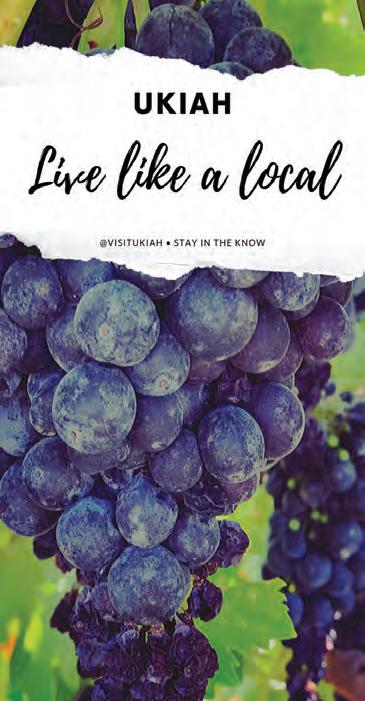

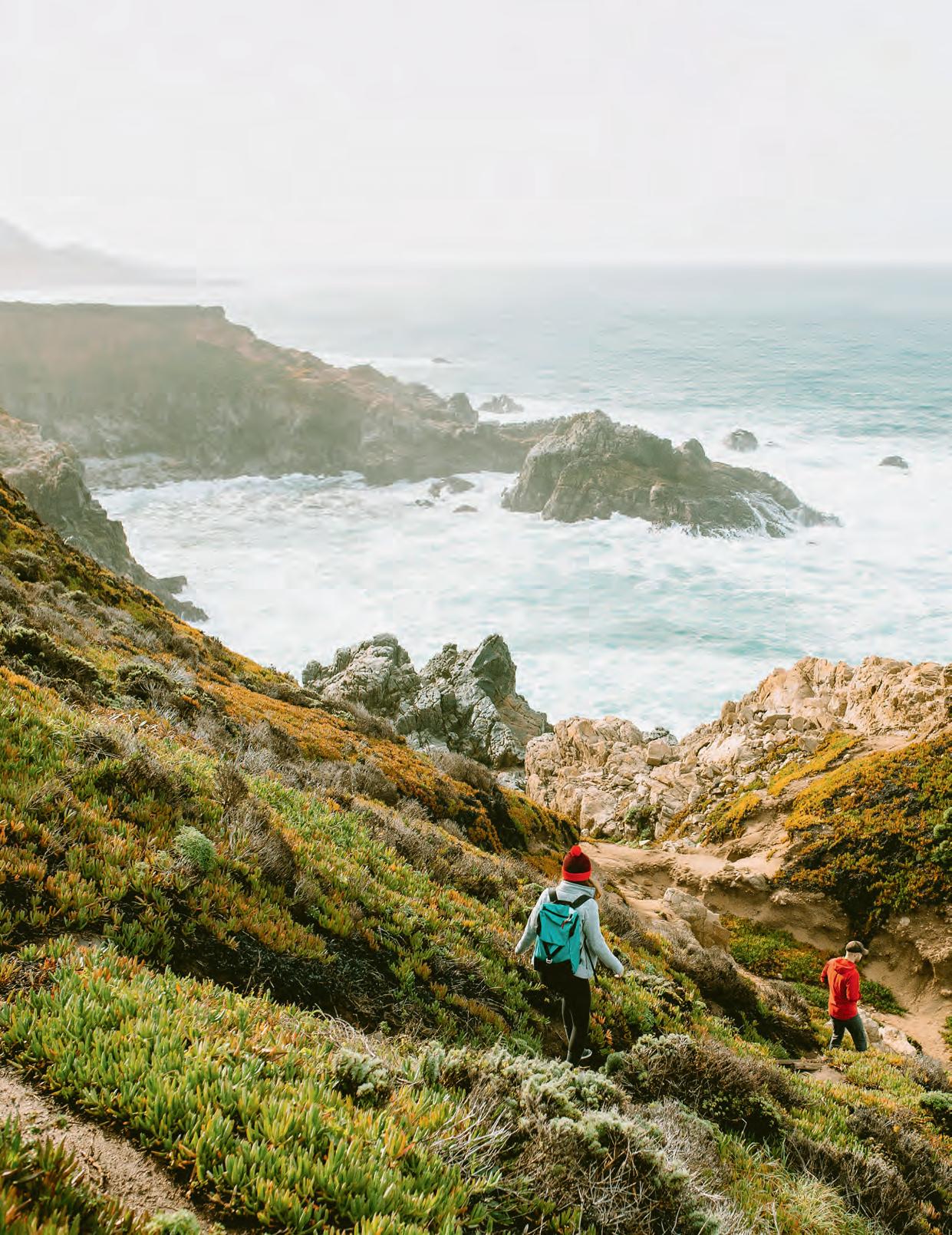

Editor’s note: Some of the sites mentioned in this section may be closed in response to the Covid-19 pandemic or recent wildfires. Before you go, please confirm the status and hours of any place you plan to visit.
Off the beaten path on California’s Big Sur coastline, there’s a pullout about a mile south of Soberanes Canyon Trailhead—near Granite Canyon Bridge—that offers rugged exploring and breathtaking vistas.
MEMBERS’ FAVORITES
↘ Ocean views, cool forests, and wildlife can be found on these treks in the West.
“Sweeping views above the Pacific Ocean in all directions can be seen on the roughly five-mile round-trip hike on the Bodega Head Trail, just northwest of Bodega Bay in California. Seabirds and sea lions can be spotted year-round, and migrating gray whales can be seen from December through April, sometimes coming close to the point.” vicki smith
“California’s McArthur–Burney Falls State Park has a wonderful one-mileloop hike that crosses Burney Creek on wooden footbridges. The forest, the switchbacks, the ever-changing views of the falls, the creek, the entire setting, plus the sounds and smells, make this a healing experience in every way.”
susan garcia
“Gray Whale Cove Trail in Pacifica, Calif., can be as easy or as hard as you want to make it. There’s a simple one-mile trail along the bluff with magnificent views of the Pacific Ocean. For a harder hike, turn inland and try Montara Mountain Trail, a vigorous climb.” raj haldankar
“The Schultz Creek Trail just outside Flagstaff, Ariz., is a beautiful hike on a tree-lined, well-maintained path. And when the weather is scorching in Phoenix, the two-hour drive north typically nets much cooler temperatures.” mary farina
“Valencia Peak in Montaña de Oro State Park in California’s San Luis Obispo County offers an exhilarating rush without a huge time or energy commit-
ment. Sea breezes cool you on the trail up to the peak, where you’ll find views of the ocean and Morro Bay. There’s also a nice cove beach in the park for relaxing after the hike.” richard bamberger
“I like to hike Redwood Regional Park in Oakland, Calif. The towering trees— 150-year-old offspring of the original oldgrowth forest—reward me with shady trails, abundant bird life, and lessons in overcoming adversity and the value of community.” sharol nelson - embry
“I love to take my family to Empire Mine State Historic Park in Grass Valley, Calif. There’s a beautiful hike through cedars, pines, and wildflowers, plus there are mining artifacts to discover. You can also tour the old mine grounds, which include a rose garden and koi ponds.” jennifer brown
“My favorite hike is the Miller Canyon Trail in the Huachuca Mountains of southern Arizona. The lower stretch of trail follows a former mining road and Miller Creek, flanked by sycamores, bigtooth maples, and Douglas fir trees. The upper stretch is more strenuous and features Gambel oaks and views of the San Pedro Valley.” robert weissler
What is your favorite place in the West to watch a winter storm, and why? Email us at otr@viamagazine.com. You may be quoted in a future issue. ?

The latest attractions, things to do, where to eat, places to stay, itineraries, maps, discounts and coupons.
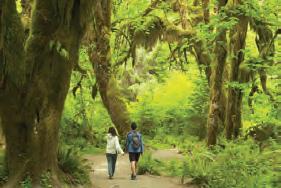




Step Away from the Rest of the World to Your Own Private Retreat
Ideal for family reunions, small-business retreats, weddings. 7 bedrooms, 4 bathrooms, 3 kitchens. Private 9-hole golf course. One square mile of forests, trails, and lakes, for one group at a time.
ALMAY RANCH • 530.266.3374
vacation@almayranch.com www.almayranch.com
Mount Diablo State Park lures hikers with diverse trails and stunning views.
It’s not surprising that newspaper magnate William Randolph Hearst once considered Mount Diablo as a site for a sprawling resort. The 3,849foot peak east of San Francisco is the highest in Contra Costa County, with views that rival those of Hearst Castle on the central coast of California. Thankfully, Hearst’s money and
energy were directed elsewhere, and in 1931 the mountain and its rolling foothills were preserved as Mount Diablo State Park. Today, the 20,000 acre, oak-studded park lures hikers with diverse trails that range from wide roads through shaded canyons to steep climbs up tall ridges.
The large sandstone formations of Rock City, on the south side, create a natural playground. Climb Sentinel Rock with the help of stairs carved into the side and a cable handrail.
Black-tailed deer and gray foxes are common, but visit in fall to catch a glimpse of Mount Diablo’s most famous creature: the tarantula. And don’t forget that view. On a clear day at the summit, you can see the Golden Gate Bridge, the San Joaquin River Delta, Mount Lassen, and even—with binoculars—Yosemite’s Sentinel Dome. leeanne jones


Listen! Plays a medley of 8 caroling classics



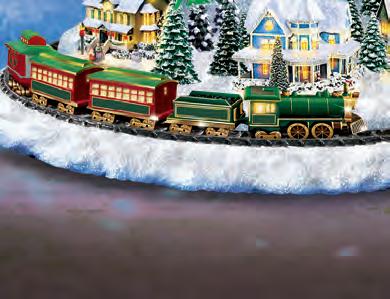



Colorful ber-optic lights usher in a brand new look for holiday tree lights, displayed for the rst time ever on an all-new limited-edition tabletop tree from Thomas Kinkade and The Bradford Exchange. Inspired by the shifting colors of the celestial lights in the northern sky, the Thomas Kinkade “Holiday Sparkle” Tabletop Tree is adorned with hundreds of mesmerizing ber-optics pulsating with light and alternating colors.

This all-new tree design stands 18 inches tall and is individually crafted to recreate the natural look of real pine. Sprinkled with glittering snow, the tree is adorned with more than 20 silver ornaments. At the touch of a button, lights dance with brilliant colors, in contrast to the single star shining at the top. More lights glow from within the sculpted Thomas Kinkade village that forms the base of the tree, circled by a moving train as a medley of eight holiday carols begins to play.

Strong demand is anticipated, so don’t delay if you wish to reserve the “Holiday Sparkle” Tabletop Tree at the $149.99* issue price, payable in four installments of $37.50, the rst due before shipment. Your satisfaction is guaranteed or your money back. Send no money now; just complete and mail the Reservation Application today!
Shown much smaller than actual size of appr. 18 inches tall. Requires batteries, not included, or use the included AC adaptor. Includes a 1-hour automatic shutoff for lights, music and motion. Intended for indoor use only.






Experience 400+ wineries at this centrally located DoubleTree Hotel. Spend your day exploring the area, or stay around the hotel, and play a round of golf or relax at the heated pool. As your day winds down, grab a glass of wine at Gather Bar & Patio. Next door to Bear Republic Brewery and one mile from Graton Casino. Ask about AAA member discounts at time of reservation.
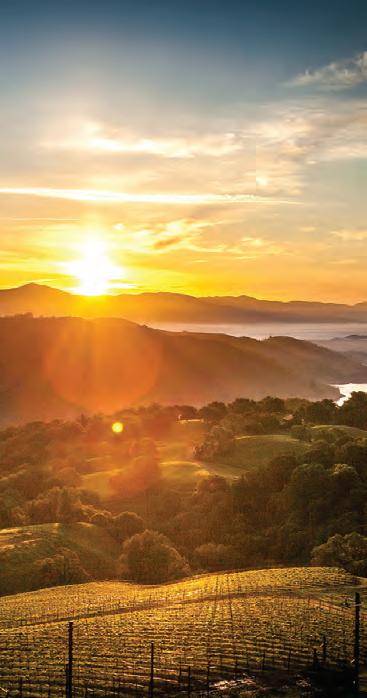
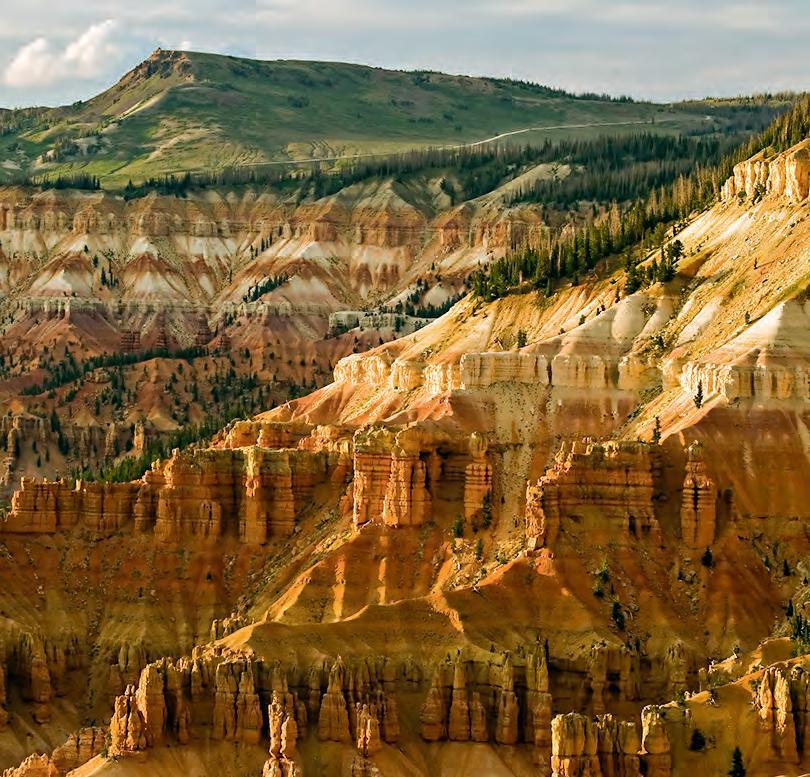
↘ High-desert delights without the crowds.
You’ve heard of Bryce and Zion and Arches, but Cedar Breaks? If it’s not on your radar, you may be missing out on some breathtaking scenery.
The national monument, about 35 miles east of Cedar City, Utah, is the little sister to the state’s betterknown parks, offering the same sculpted surreality of weathered high desert but with fewer visitors.
Franklin D. Roosevelt set aside this natural half-mile-deep amphitheater in 1933 for its “spectacular cliffs, can-
yons, and features of scenic, scientific, and educational interest.”
Translation: teetering hoodoos and cotton-candy-colored rocks punctuated by some of the longest living trees on Earth.
The Alpine Pond Nature Trail takes you down to stunning regions of the monument on a two-mile loop within a loop that allows you to tailor the length of your walk. Halfway along you’ll find the spring-fed Alpine Pond, a fine place for a picnic. A fourmile round-trip hike to Spectra Point on the Ramparts Trail passes through stands of bristlecone pines, the oldest of which first sprouted in the area around a.d. 300.
Cedar Breaks sits at 10,000 feet above sea level, making for awesome stargazing. On Saturday nights throughout the summer, rangers host star parties with lectures and telescopes. —tim neville











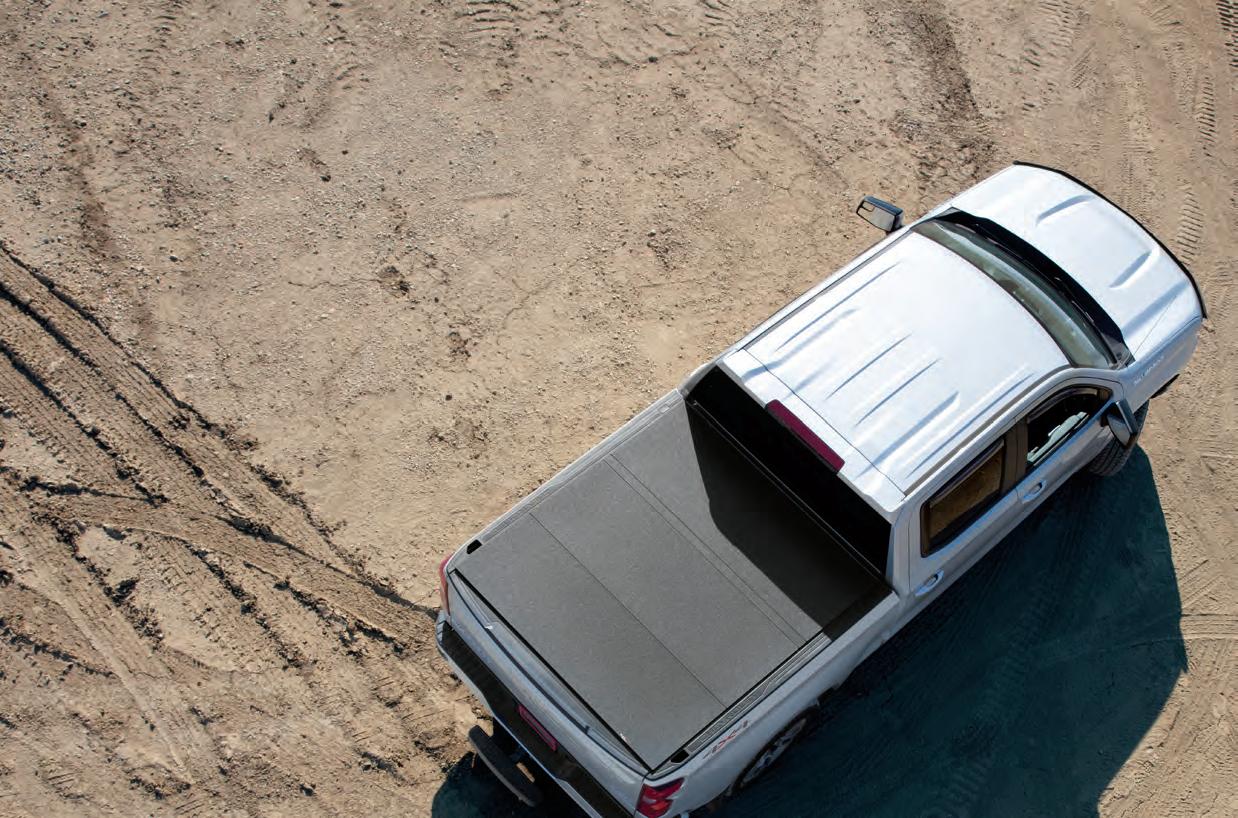


























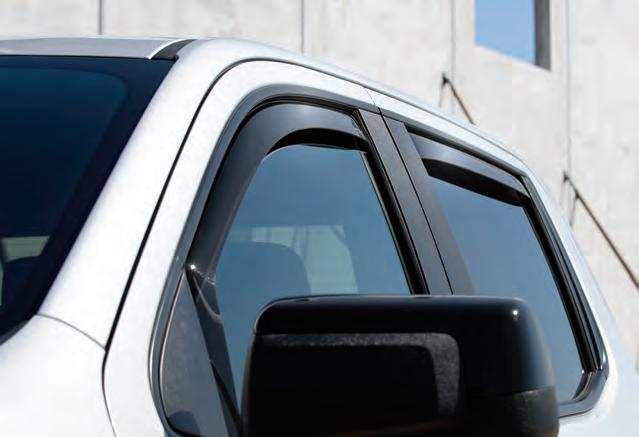









Take advantage of everyday discounts available to you as a AAA Member. Save 30¢ per gallon on your first fill-up at Shell when you join the Fuel Rewards® program at AAA.com/shell by October 31, 2020*. Keep saving all year long with more discounts below.



We’re going to let you in on a secret. Billionaires have billions because they know value is not increased by an inflated price. They avoid big name markups, and aren’t swayed by flashy advertising. When you look on their wrist you’ll find a classic timepiece, not a cry for attention–– because they know true value comes from keeping more money in their pocket. We agree with this thinking wholeheartedly. And, so do our two-and-a-half million clients. It’s time you got in on the secret too. The Jet-Setter Chronograph can go up against the best chronographs in the market, deliver more accuracy and style than the “luxury” brands, and all for far, far less. $1,150 is what the Jet-Setter Chronograph would cost you with nothing more than a different name on the face.
With over two million timepieces sold (and counting), we know a thing or two about creating watches people love. The Jet-Setter Chronograph gives you what you need to master time and keeps the superfluous stuff out of the equation. A classic in the looks department and a stainless steel power tool of construction, this is all the watch you need. And, then some.
Your satisfaction is 100% guaranteed. Experience the Jet-Setter Chronograph for 30 days. If you’re not convinced you got excellence for less, send it back for a refund of the item price.
Time is running out. Now that the secret’s out, we can’t guarantee this $39 chronograph will stick around long. Don’t overpay to be underwhelmed. Put a precision chronograph on your wrist for just $39 and laugh all the way to the bank. Call today!



Limited to the first 1900 responders to this ad only.

IT’S BEEN AN EVENTFUL YEAR, but we’ve been working hard to bring even more entertainment options for you to enjoy safely alongside your friends and family! The Salt River Indian Community’s Talking Stick Entertainment District is the biggest and best place to play and stay and we hope that while visiting, you’ll find time to explore new properties like Great Wolf Lodge AZ, Medieval Times Dinner and Tournament and the USS Arizona Memorial Gardens at Salt River. Salt River’s heritage of hospitality is shining through and we look forward to seeing you soon!

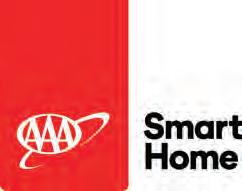

Being a good driver isn’t just a matter of following the laws of the road. It’s also about sharing that road safely with others. Little things such as taking turns and giving thanks—which we all learned as children, but which some of us occasionally forget— are the keys to being a truly good driver. And driving politely is not just about being virtuous for its own sake. “Small efforts in courtesy can yield big reductions in risk for everybody,” says William Van Tassel, manager of AAA driver training programs. Here are some ways you can make the road more civilized and less hazardous.
by avital andrews
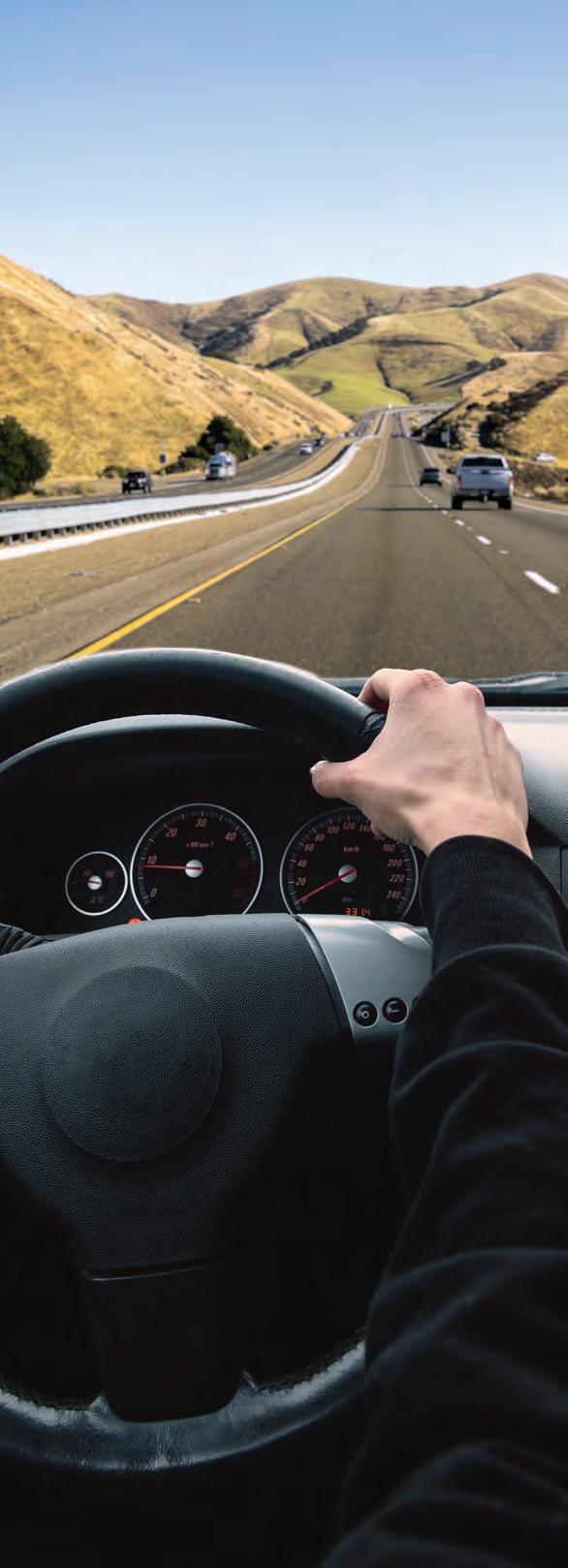
Lately we’ve grown accustomed to giving other people ample personal space when we’re out and about on foot. That’s always been the imperative behind the wheel, yet more than half of U.S. drivers admit to following other vehicles too closely. Tailgating is not only likely to make other drivers nervous or angry, but it’s also a leading cause of rear-end crashes.
Leaving room between your car and others gives you enough reaction time in case something unexpected happens. Remember the three-second rule: Keep three seconds of travel time between you and the next vehicle. In adverse conditions such as rain or fog, make it six.




2Change lanes correctly. Always use your blinker to signal your intention to change lanes, then turn it off once you’ve made your move. The highway’s left lane should be reserved for passing; once you’ve overtaken a slower vehicle, move back to the right. In heavy traffic, don’t keep changing lanes under the illusion that it’ll get you where you’re going faster. It won’t. However, you really should change lanes when a car is entering the road from an on-ramp in front of you. Move over to give it room—a maneuver Van Tassel calls a courtesy lane change.


3. Lay off the brakes. Don’t stop in the roadway unless it’s absolutely necessary. Slowing to gawk at a crash is especially impolite; rubbernecking is, as the Emily Post Institute puts it, “disrespectful to the victims, a hindrance to those trying to help, and a sure way to cause a traffic backup.”
As much as possible, keep moving at a steady speed. If you must stop for a hazard ahead, Van Tassel recommends tapping the brake pedal a few times to flash your red lights before fully applying the brakes. “That gives those behind you a heads-up and makes it a lot less likely you’ll get hit,” he says.
4. Stop speeding. Unless you’re driving an ambulance or you have an about-to-deliver mother on board, exceeding the speed limit is illegal and rude. It’s also ineffective: Studies show that speeding doesn’t save as much time as most people think it does. In addition, it’s a factor in one-third of all fatal collisions nationwide. Instead of rushing to arrive on time, leave home earlier. And don’t hurry others along. If the driver ahead of you makes an extra-slow turn, don’t assume it’s out of timidity or incompetence; perhaps there’s a baby or other precious cargo in the backseat.
5. Consider your passengers. When you have company in your car, be mindful of your passengers’ comfort and safety. Make sure your riders are buckled up before taking off. Ask if they’re OK with the temperature and music. On a long drive, check in often to see if anyone needs a break. Be courteous when you’re the passenger, too. Pay your share for fuel. If you stop at a gas station, help pump gas or clean the windshield. Don’t distract or criticize your driver. Do stay awake, offer to navigate, handle incoming calls and texts, and keep your feet off the dash.


Expressing gratitude is as important on the road as it is elsewhere. So if someone lets you merge or does something else to make your drive more pleasant, give her a wave or nod. Got tinted windows? Roll ’em down so the recipient sees your grateful gesture. Like opening a door for someone or smiling at him, these little things can completely change attitudes. And if you can make someone who’s operating a 3,000-pound machine at high speed feel better, why not?
7. Honk politely. Your horn is a communication tool, and knowing when and how to use it is crucial. Unfortunately, 45 percent of U.S. drivers honk to display annoyance or anger. Don’t honk to intimidate a slow-moving driver or to let someone know that she erred. Instead, use your horn only to alert others to danger or to prevent a crash. You can also sound it on narrow, winding roads. Your horn sounds much louder outside your car than inside, and can be startling, especially if you deploy one long blast. “If you need to use it,” says Van Tassel, “a couple of quick taps are usually enough.”
Communicate. Don’t restrict your communications to thankyous. “The most important aspect of courteous driving,” says Van Tassel, “is to acknowledge the presence of other road users.” That means being aware of those around you and communicating with them with signals and waves. Eye contact is particularly important: It can help you acknowledge those other drivers, alert them to your intentions, and anticipate their next moves.
Be careful at intersections. When two or more streets meet, there’s always room for error and misunderstanding. Keep a few guidelines in mind when you approach any intersection. First, make sure before you enter it that there’s enough space for you on the other side. You don’t want to end up stuck in the middle. Second, don’t treat a stoplight as an opportunity to look at your phone. You might miss the light change when it happens, which could delay drivers behind you. Finally, don’t insist on the right-of-way. Even when it’s legally your turn to go, if another driver goes first, take a deep breath and let them pass.
10. Take turns merging. When two lanes are turning into one and you have to move over, use the zipper merge: Continue in the lane you’re in for as long as possible; then, when that lane ends, take turns merging with cars in the remaining lane in a you-go-I-go sequence. It might feel like you’re cutting in—but studies have shown that if everyone used this method, it would reduce congestion and fender benders.


Share the road. Pay close attention to pedestrians and bicyclists. Protect them by staying alert, giving them a wide berth, and passing only when safe and necessary. When exiting your vehicle after parallel parking, avoid “dooring” a moving bicycle by doing the Dutch reach: Instead of opening the door with your left hand, reach over to use your right hand while twisting a bit to look behind you for approaching cyclists.
12. Know how to park. “Parking lots can be a nightmare,” says Van Tassel. “There’s huge potential for conflict.” He suggests parking away from clusters of other cars whenever possible, to maximize visibility when you’re backing out. Better yet, back in: Parking with the front of your car pointing into the lane means better visibility when you’re leaving. Parking far from the crowd also means you won’t accidentally ding someone
else’s door when getting out. More parking tips: Stop to let others back out. Don’t park in nondesignated spots. Don’t have someone stand in an empty space to save it. And never steal a spot when someone has been waiting to turn into it. Parallel parking along a curb? Leave room for others to park on the street, too. The California DMV suggests you keep two feet between your car and those in front and back.


Manage your temper. This one may be more easily said than done. But aggressive, angry driving is a leading cause of car crashes. So do whatever it takes to keep your cool: Pull over, take deep breaths, listen to something soothing, and remember that, like you, other drivers are only human. If another driver does something that frazzles your brain, try to compassionately imagine some good reason why he might have
done it. Is someone tailgating you? Perhaps she’s on her way to visit a sick relative in the hospital. Also, remember that anger is as contagious as kindness. Your actions ripple through the world. “If you must gesture when you’re frustrated,” says Van Tassel, “keep your hands below the dashboard. Anything that’s visible should be nice.” Should you encounter a driver with road rage, don’t respond. Avoid eye contact, stay in your car, and try to reframe the incident as an opportunity to practice patience and compassion. You never know what someone else is going through.
By improving visibility, high beams can make driving at night much safer. But you should always lower the lights for oncoming vehicles and for others in close proximity. In that last case, your lights can reflect in the driver’s rear-view mirror and impair his ability to see. 14

15. Keep trash in. Don’t be a litterbug. Cigarette butts flicked out of windows start wildfires. Garbage flying out of cars can cause collisions, spread disease, and even kill animals. “Plan ahead by bringing a plastic grocery bag along to be your trash can,” advises Van Tassel. “Keep it in the car and throw it away later.”

Maintain your vehicle. A well maintained car is safer for you and it can help everyone else on the road, too. Breakdowns can cause traffic jams or even crashes. If nothing else, any car that drips oil or coolant onto the street (and from there into storm drains) is making the world a dirtier place. So take your trusty ride in for regular service, and if issues come up, address them promptly. AAA Members get 10 percent off labor at AAA Approved Auto Repair shops, plus a two-year warranty on every fix. Find a shop near you at AAA.com/autorepair.

When you download and use the AAA Mobile app, you can order roadside and battery service, gain access to your online Membership account, find money-saving discounts, and more. Put AAA at your fingertips today by visiting AAA.com/mobileapp.
AAA Mobile app is a joint offering in collaboration with AAA-National, offering nationwide access, Member discounts, roadside assistance, travel planning tools, and more. You must have a valid AAA Membership to use this app. For full details on AAA Membership, visit aaa.com/membership-terms-and-conditions. © 2020 AAA Northern California, Nevada & Utah. All rights reserved.

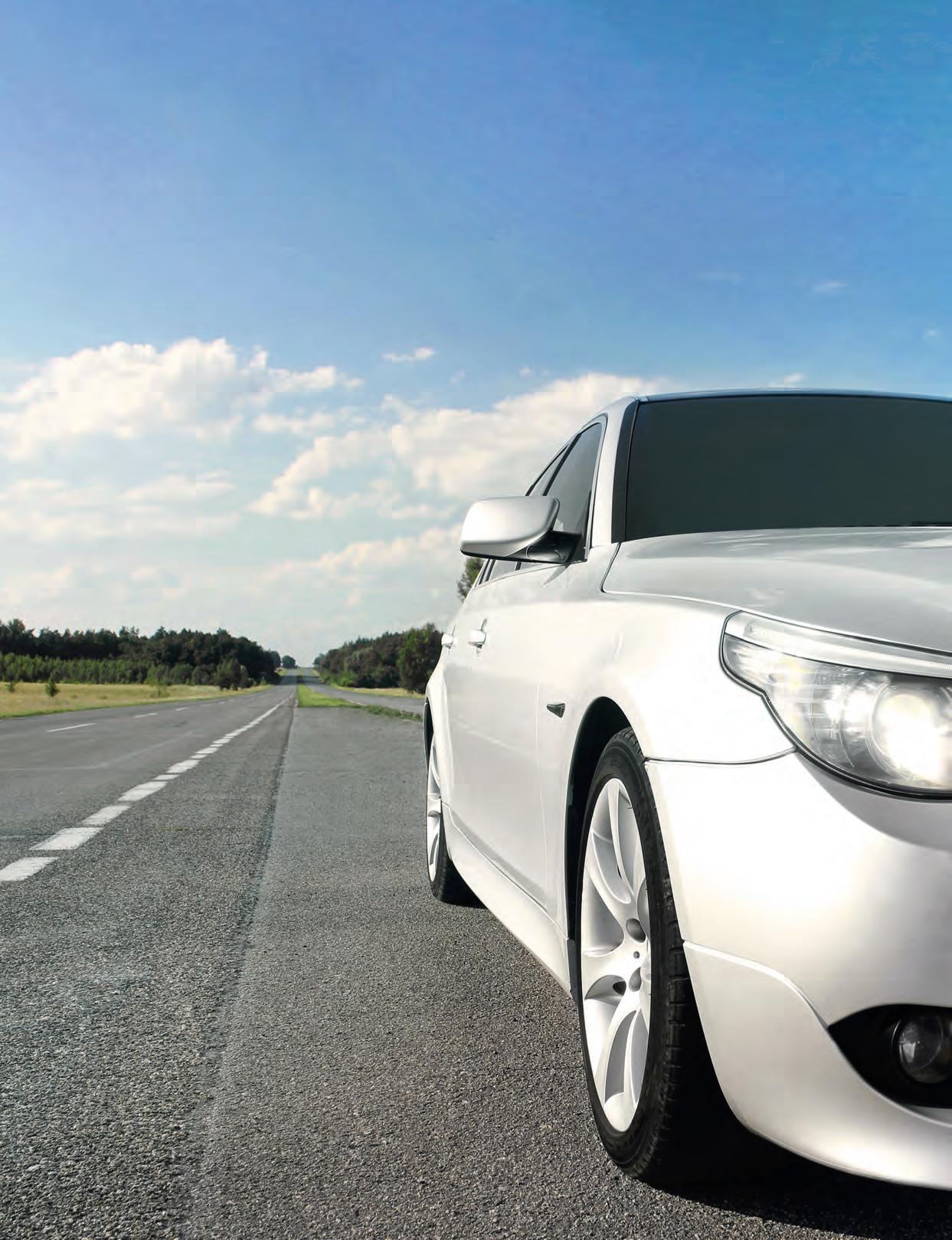
Today’s advanced driver assistance systems can do amazing things. But they can’t do all the driving for you—at least not yet.
by josh sens

The next vehicle you buy might not fly, but chances are it will have features that would have seemed like futuristic fantasies just a few years ago. More than 90 percent of new vehicles available in the United States today include at least one form of advanced driver assistance systems (ADAS)—automatic emergency braking, collision warnings, and the like. And those systems are growing more sophisticated—and their use more widespread—every year.
As common as they are these days, though, ADAS can also be a source of confusion. One reason is that different manufacturers may refer
to a single technology by a bewildering array of proprietary names. The absence of consistent terminology makes it difficult for consumers to know which features a given vehicle has and how those features work. Technologies with similar names might actually do different things: One car will just warn you about an impending collision, while another will actually hit the brakes.
For such systems to live up to their full potential, clarity is crucial. Here are seven of the most common ADAS technologies, using standardized names proposed by AAA, with explanations of what they can—and, more importantly, what they can’t—do.

By 2022, more than 95 percent of cars available in the United States will have automatic emergency braking. The system uses either radar or a combination of radar and cameras to detect potential obstacles ahead of you and apply the brakes.
But not all these systems are created equal. “Some are designed to do everything within the laws of physics to stop your car,” says Greg Brannon, director of Automotive Engineering and Industry Relations at AAA National. “Others are designed just to mitigate the collision.”
What’s more, while some systems can only detect other vehicles in your path, others are capable of responding to cyclists, pedestrians, and animals. In all cases, these systems respond best to objects in motion; they are not good at responding to, say, a lamppost or a mailbox. And in no case are they meant to do all the braking for you. “You should not be relying on these systems to stop your car,” Brannon says. “They are meant to be a backstop for drivers engaged in the task of driving.”
AKA:
Active Brake Assist
Collision Mitigation Braking System
Collision Prevention Assist Plus
Forward Automatic Braking
Forward Collision Avoidance Assist
Forward Collision Mitigation
Forward Collision Warning
Forward Emergency Braking
Front Pedestrian Braking
Intelligent Brake Assist
Pre-Collision Assist
Pre-Collision System
Pre-Safe Brake
Smart Brake Support

In 2018, about 14 percent of new cars nationwide had some form of lane keeping assistance. The technology uses camera-based sensors to detect lane markings. If it “sees” that you’re drifting unintentionally out of your lane, it springs into action. Some versions steer your vehicle back to center when they sense you’re about to cross a line. Others try to keep you centered in your lane at all times (which can lead to a disconcerting ping-pong effect). The systems are smart enough not to intervene when you’re purposely changing lanes.
Because lane keeping assistance relies on cameras, it is less effective at night. Add rain or snow to low-light conditions, and the system may cease to function altogether, Brannon says. More importantly, the technology isn’t meant to do the steering for you, and it’s certainly not infallible. It does not work well in construction zones or on other stretches of road where the lane markings are unclear or shift suddenly. “Don’t get lulled into a false sense of security,” Brannon says. “Lane keeping assistance doesn’t mean you have a self-driving car.”
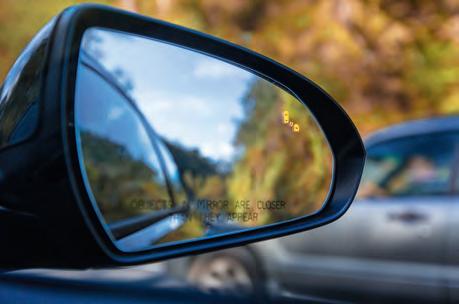
AKA:
Blind Spot Assist
Blind Spot Detection
Blind Spot Information
Blind Spot Intervention
Blind Spot Monitor
Lane Change Assistant
Smart Blind Spot Detection
Available in more than 80 percent of new cars in this country, blind spot warning systems rely on rear-facing cameras built into the sideview mirrors, frequently supplemented by radar systems at the rear of the car. These technologies keep watch on the road behind you and alert you when they detect approaching vehicles in adjacent lanes. In a lot of these systems, the alert appears as an amber light near the side mirror. However, if you switch on your turn signal to change lanes, many systems augment their visual alert by emitting an audible beep or by vibrating your seat.
The larger the object and slower it’s moving relative to your speed, the easier it is for these systems to detect. This means blind spot warning systems are better at detecting cars than motorcycles, which are not only smaller but often moving too quickly for easy detection. Another important note: These systems only issue warnings. The car itself will not take action. “You still need to check your mirrors and use your signals,” Brannon says.

AKA:
Active Distance Assist Distronic
Advanced Smart Cruise Control
All-Speed Dynamic Cruise Control
Camera-Based Cruise Control
Distance Pilot Distronic
Dynamic Radar Cruise Control
Intelligent Cruise Control
Smart Cruise Control
Traffic-Aware Cruise Control
Adaptive cruise control has been around for more than a decade, over which time it has slowly made inroads into the marketplace. In 2018, the radar-based system was a standard feature in just over 13 percent of new vehicles in the U.S. Unlike standard cruise control, which keeps your vehicle at a constant speed, adaptive cruise control adjusts your speed to maintain a constant gap between you and the vehicle in front.
The systems are user adjustable, so you can specify the separation between you and the car ahead. (AAA recommends at least three seconds.) “They’re designed to smooth patterns and ease some of the stress of driving on the interstate,” Brannon says. “And our research has found that they work very well.”
While some systems are capable of bringing your vehicle to a complete stop, not all of them can. “Adaptive cruise control does not necessarily mean you have automatic braking,” Brannon says. “Don’t assume it will slow you down if the vehicle ahead slams on its brakes.”

AKA:
Backup Collision Intervention
Collision Prevention Assist
Cross Traffic Warning
Cross Path Detection
Forward Collision Alert
Moving Object Detection
Rear Cross Path Detection
Rear Cross Traffic Alert
Rear Cross Traffic Assist
Rear Cross Traffic Monitor
Rear Traffic Alert
Rear Traffic Monitor
Reverse Traffic Detection
Forward collision warning systems will be standard in all new vehicles sold nationwide as of 2022. They watch the road ahead with cameras and radar-based sensors and alert you to potential impacts with vehicles ahead of you.
However, these systems are not especially adept at detecting cyclists and pedestrians. And none of them are as good as you might like when you’re driving at full speed and the vehicle ahead of you changes lanes suddenly to reveal a stationary object in your path.
Automatic high beams first appeared in the 1950s and are now available in a majority of new vehicles nationwide. These systems use light sensors to monitor driving conditions and adjust headlight settings accordingly, switching to high beams in low-light settings, then dimming those same beams when that’s called for, in response to oncoming traffic. In the United States, more than two-thirds of drivers report that they do not use their high beams manually—a troublesome statistic, Brannon says, given that low beams have been shown to be ineffective on dark roads at speeds of 45 mph or greater. That makes automatic high beams an especially valuable tool.
The technology can be fooled: If your lights hit a reflective surface, the system might interpret that as an oncoming vehicle. If the sensors get cloudy or caked in mud, their effectiveness may be minimized. “It is incumbent on drivers to check that these systems are working properly,” Brannon says.
While these are primarily warning systems, they are often paired with automatic emergency braking (see page 33), which will actually respond to the obstacles ahead.
Rear cross traffic collision warning systems perform a similar function when you’re backing up; they use radar, sonar, and in some cases cameras to detect vehicles coming from the side as you’re in reverse. Again, the smaller the object and the faster it’s moving, the harder it is for these systems to detect.

High Beam Control
Highbeam Assist Auto High Beam
High Beam Assist
High Beam Control
IntelliBeam
Intelligent High Beam
Light Assist
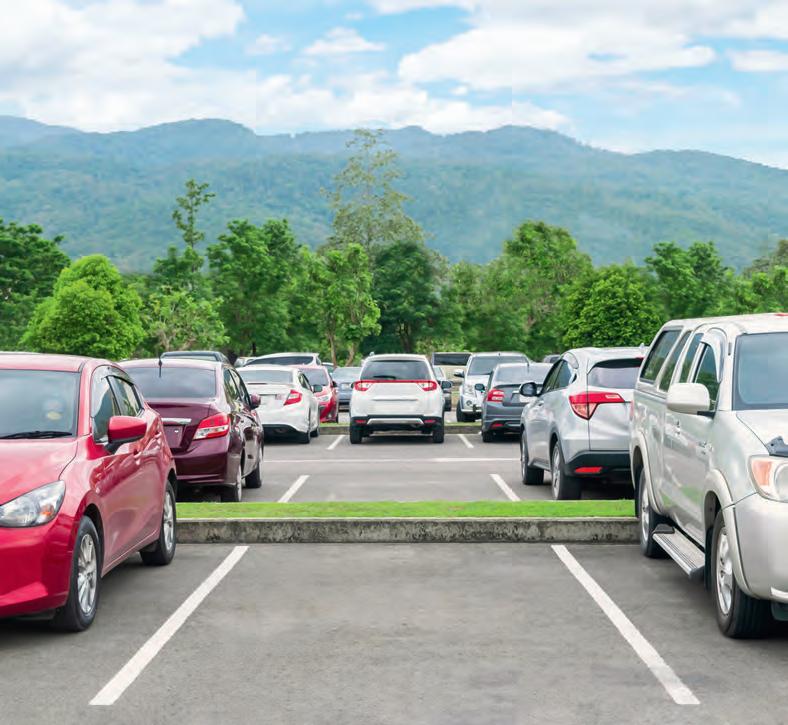
AKA:
Active Park Assist
Active Parking Assist
Automatic Parking Assist
Intelligent Park Assist
Parallel and Perpendicular Park Assist
Park Assist
Park Assist Pilot
Parking Assistant
Parking Assistant Plus
Parking Pilot
Parking Steering Assistant
ParkSense
Increasingly common as an optional upgrade, active parking assistance uses sonar, radar, and cameras to help you pull safety into a parking space. What varies is the degree to which these systems get involved in the parking process itself. Some will not only handle the steering and braking, they’ll also do the shifting—moving the car from forward to reverse or vice versa—as needed. Others will do the steering only, leaving the driver to shift and brake. “There are a lot of different flavors,” Brannon says. “As a driver, you really need to know exactly what the vehicle is relying on you to do.” Active parking assistance systems do not engage automatically; you have to turn them on when you start looking for a spot. They’ll help you identify whether a spot is big enough to fit your car, and they usually do a very nice job of maneuvering the vehicle into it.
“Typically, these systems do an even better job than good drivers,” Brannon says. “They hit the curb less frequently, and they generally require fewer adjustments after that initial park.”
Super Cruise. Autopilot. ProPilot Assist. The names sound supercool. Too bad they’ve also kicked up a cloud of confusion about technologies that AAA believes should be referred to as active driving assistance. Whatever you call them, these technologies combine aspects of adaptive cruise control and lane keeping assistance (see pages 34 and 35)—essentially steering, braking, and accelerating for you as conditions permit. They work well on the open road and in stopand-go highway traffic, Brannon says, but less well in moderate traffic where gaps between vehicles change frequently. And what they can’t do in any circumstance—regardless of what all those spiffy names suggest—is take over all the driving for you. Unfortunately, many drivers won’t understand the limitations until it’s too late. “We can’t control the marketers,” Brannon says. “But the nomenclature is a safety issue.” ●
josh sens also writes for Golf, the New York Times, and Men’s Journal.

Come fall, the fog and the crowds dissipate, and the road is wide open.
by josh sens
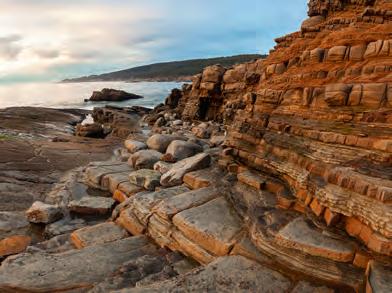


One autumn evening, as the sun sank over the sleepy seaside town of Jenner, Calif., my wife and I sat down for dinner and a show.
Dinner was lamb burgers and beet salad. The show starred squadrons of pelicans and cormorants winging low over the waves. We watched them from our table on the deck at River’s End Restaurant & Inn, which overlooks the coastal junction where the Russian River spills into the Pacific, roughly two hours north of San Francisco.
The birds seemed in a hurry, zipping across the pink horizon, but we were in no rush. We were at the start of a three-day road trip up Highway 1, along an unspoiled stretch of Northern California that blends off-the-grid beauty with touches of wine country chic. The route we had mapped, from tiny Jenner (population 136) to the justabout-as-tiny community of Elk, was barely 70 miles. Leisurely is the best way to travel this western fringe of Sonoma County, and fall is the ideal time. The fog has mostly disappeared, and the crowds of summer are mostly gone too.
The only plan we had was not to do much planning. We figured we would stop when inspiration struck, and we knew it would do so often, at scenic lookouts, lonely beaches, wooded trails, historic landmarks, and restaurants serving superb seasonal cuisine.
S ign up now for seaweed harvesting classes ! read a posted note I came across the next morning when we fueled up in downtown Jenner—though calling it a downtown might be a bit of an exaggeration. A small cluster of wood-
shingled, waterfront buildings, it’s anchored by a visitor center, a wine shop, a gas station, and a caffeination hot spot called Cafe Aquatica, where we grabbed cappuccinos and fresh-baked berry scones before heading out.
It was just past daybreak, and we owned the road. You know those car commercials that show a solo vehicle snaking up a dreamy-looking highway? That was us on our serpentine path. To the left, a craggy, foam-kissed coastline with wildly sculpted rock outcrops rising just offshore. To the right, maritime chaparral interspersed with stands of redwood, oak, and Douglas fir.
Just north of Jenner in the shadow of Pole Mountain, the highest peak on the Sonoma coast, we pulled into an empty parking lot. A sign marked the start of the Sea to Sky Trail, which climbs into the headlands and lives up to its billing with the panoramas it commands. Though the trail extends for 15 miles up and back, we only had to hoof it a few hundred feet to enjoy an eyeful of hills and ocean, and to see a herd of “Oreo cows”—belted Galloways, known for their distinctive black-and-white sandwich pattern—grazing in the grassy folds nearby.
Ranching was not a way of life for the earliest known inhabitants of the region, the Kashia Pomo people, who hunted and gathered in the inland hills and along the coast. Their first sustained contact with outsiders came in the early 1800s, when Russian seafarers sailed down from Alaska and established a settlement at what is now Fort Ross State Historic Park. Though protected by cannons and a palisade, Fort Ross was a
Editor’s note: Some of the sites mentioned in this story may be closed in response to the Covid-19 pandemic or recent wildfires. Before you go, please confirm the status and hours of any place you plan to visit.
from top left: Weathered, layered sandstone at Salt Point State Park; watching the sun set from River’s End Restaurant & Inn in Jenner; the rancher’s salad at River’s End. opposite: A visitor standing on the honeycombed rocks known as tafoni at Salt Point.
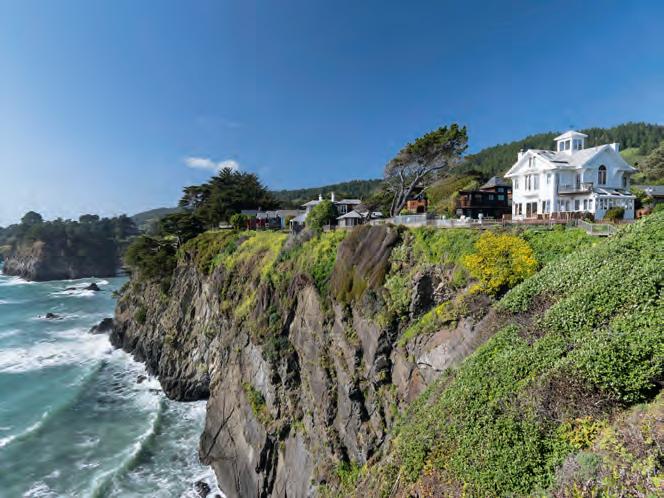



We sat quietly on smooth redwood benches, taking deep, meditative breaths.
commercial outpost, focused on farming, manufacturing, and fur trading. It was also where the first windmill in California was built.
Of the original structures here, only one— Rotchev House, home of the fort’s last manager— remains. But over time a number of others have been faithfully rebuilt. Inside the walls of the fort, we admired the chapel and stockade, then toured the officers’ quarters, with their creaky floorboards and sparse furnishings. Life at the fort was rustic, to say the least.
These days there are comfier spots to stay. Three miles farther north, we paused for a respite at Timber Cove Resort. After a snack at Coast Kitchen, we strolled along the bluffs in back, following a walking trail to a striking landmark: a 93-foot-tall obelisk with a large open hand rising from its top. Titled The Expanding Universe, the towering sculpture was created in the 1960s by artist Benny Bufano as a symbol of peace.
Of course, nothing conveys serenity quite like nature, which displayed its splendor everywhere we turned. The spectacle was especially stunning at Salt Point State Park, where more than 20 miles of hiking trails lattice the area, from windlashed headlands to woodsy ridges. Here we took a short, steep uphill walk to a pygmy forest of pine and cypress. Below us, sandstone bluffs tumbled toward tidal pools and kelp beds so abundant with life, they’re protected as the Gerstle Cove State Marine Reserve.
Sustainability is a constant theme along the coast. It was part of the founding ethos of Sea Ranch, a residential community set on 10 miles of shoreline just shy of the Mendocino County border. Designed and built in the 1960s, Sea Ranch reflects the idealism of that decade, with shared open spaces and unpainted wooden homes meant to blend harmoniously with their surroundings. Several public roads cut through the development, granting easy access to the rocky coast.

We turned inland instead, to the Sea Ranch Chapel. It’s an architectural marvel: a one-room nondenominational sanctuary with a swooping roof that calls to mind an ornate shell and an interior of stained glass, iron, and stone. Stepping inside, we sat quietly on smooth redwood benches, taking deep, meditative breaths. Sunlight played through the windows, splashing in kaleidoscopic colors on the mosaic floor.
I was still feeling relaxed and mindful later that afternoon when we pulled into Point Arena for a glimpse of another notable structure. Set on a promontory at the northwest edge of the small coastal city, the Point Arena Light Station rises 115 feet, tying with the lighthouse at Pigeon Point south of San Francisco for the honor of tallest such beacon in California. November through January, the bluffs around the lighthouse become prime whale-watching grounds, as gray whales work their way south toward warmer waters.
If you arrive at Point Arena at low tide, as we did, make a beeline for Bowling Ball Beach, where the receding waters reveal the large round rocks just offshore that give the beach its name.
The next day, we eased north from Point Arena to Elk. First settled by homesteaders in the 1800s, the town boomed a century ago, thanks to the lumber industry. Back then, its population was about 20 times what it is today. The vibe has changed.
These days, visitors come for the quietude and comfort. Many come for Harbor House Inn, a graceful 11-room retreat that is home to the only Michelin-starred kitchen on this stretch of the coast. We opted instead for the Elk Store, which specializes in classic sandwiches done California style, with local beer and wine to wash them down.
With a tuna melt for my wife, and a housesmoked pork belly banh mi for me, we ambled across the road and down a trail for a picnic lunch on driftwood-dotted Greenwood State Beach. The sun was still high, but we were in no hurry. We lingered for a few hours in that blissful setting, watching as the daylight waned, and waiting for another sunset show to begin. ●
josh sens also writes for Golf, the New York Times, and Men’s Journal.
above: Dinner on the patio at Harbor House Inn. opposite, clockwise from top: Cliffside lodging on the Mendocino coast; a cannon and the rebuilt chapel at Fort Ross; the Benny Bufano sculpture on the grounds at Timber Cove Resort; grilled abalone with coastal succulents and fermented field mustard broth at Harbor House.
Here’s how to plan an RV road trip.
by laura kiniry
or a novice like me, sitting behind the wheel of a 2003 Dodge Sprinter that has been converted into a camper van is both exciting and unnerving. I’ve never rented or driven anything bigger than a four-door sedan. Thankfully, owner Alex Burr is more than happy to show me the ropes. His 21-foot-long vacation home on wheels is a snug space with room for four, complete with an outdoor shower and a solar-charged electrical system (but, alas, no toilet). He lists it on Outdoorsy, an RV rental marketplace that’s like Airbnb for motor homes. You find an RV that suits you, talk with its owner to see if you’re the right fit for it, and then arrange for a pickup—which in my case was as simple as taking public transit from
San Francisco to Burr’s Oakland, Calif., home, where he handed over the keys. Since the pandemic began in midMarch, demand for recreational vehicles has skyrocketed nationwide. Companies such as Outdoorsy, El Monte RV, and RV Trader are seeing record numbers of buyers and renters. In fact, RV Trader’s online traffic is up 76 percent this year compared to last, according to its vice president, Paige Bouma. But if you’re itching to get outside and explore the West’s open roads, you’re also in luck. The RV experts and full-time RVers I spoke with will help prepare you for the ultimate road trip, from learning how to drive an RV to finding the best spots in the West to bed down beneath the stars.


The first thing to do is to figure out the best RV for your family’s size and requirements, and next ensure you have everything you need to make life on the road as convenient and comfortable as possible.
There are lots of makes, models, sizes, and styles of RVs to choose from. But narrowing down the selection is also part of the fun. “When you’re looking at RVs, the first thing you should ask yourself is, ‘What kind of person am I?’” says Heath Padgett, a full-time RVer who has been living on the road with his wife, Alyssa (author of A Beginner’s Guide to Living in an RV: Everything I Wish I Knew), since 2014. The term RV refers to a motor vehicle or trailer that features living accessories and overnight lodging facilities. These range from basic camper vans outfitted with little more than a bed and a propane stove to motor homes over 40 feet long resembling houses on wheels.
There are three main classes of motor homes: A, B, and C. Averaging 33 feet in length, Class A

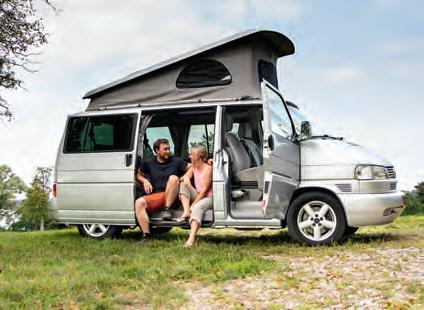
vehicles are the largest and most spacious of the three and can typically sleep six to eight people. They’re also the most luxurious, often outfitted with full kitchens and “slideouts” (extensions that enlarge the living space), though their extreme size makes handling them somewhat tricky. Class B motor homes usually run between 18 and 22 feet long and are the most compact of the three main classes. They drive much like regular passenger vans, making them ideal for first-time renters, and what they lack in space (most sleep one to two people) they make up for in convenience. Class B is usually easier to park in a regular parking space, more fuel efficient and affordable to rent, and ideal for a quick weekend getaway, either solo or with a friend or partner. “If you like being spontaneous and discovering hidden back roads and small towns, then a Class B is probably for you,”


says Padgett. They don’t always have bathrooms, which is something to keep in mind.
Class C is considered the Goldilocks’ choice of motor homes. Averaging between 30 and 33 feet and ideal for a family of four, they make good use of their space, with features like overhead bunks or fold-down dining tables that convert into beds. If you’re more of an adventurer, says Outdoorsy cofounder Jen Young, consider a lightweight pop-up trailer that’s easily collapsible and that you can pull behind your car or SUV. “This way you can unhook it and head off exploring, and it will be waiting when you return,” she says. Other types include flatbed campers that you can attach to the bed of a truck, and towables such as cozy teardrop-shaped campers and fifth wheels, which require a pickup truck. Another option is to have the RV experience without driving one. Sixty percent of Outdoorsy’s RV owners offer delivery and pickup. “The owner will bring it to your site, set it all up for you—like stringing the lights and filling the water tank—and then take it away when you’re through,” says Young.



Once you’ve chosen an RV size and style, start thinking about amenities and how you’re planning to use the vehicle. Will you be cooking a lot? Look for an RV with an oven, or at the very least a propane stove. Hoping to find a quiet place in the forest to nap en route to your campsite? This is called boondocking, or dry camping, meaning there’s no access to external electricity and water supplies. Consider a camper with solar panels like Alex Burr’s converted Sprinter or look for an RV with a deep-cycle battery included, so you can power your fan, lights, and laptop overnight if needed.
Most RV rental companies offer basic insurance with both liability protection and physical damage protection for the vehicle. Some—like Outdoorsy—provide round-theclock live support for the duration of your trip. However, just as you would when renting a car, you want to make sure to cover your bases. Depending on what you’re comfortable with, you may opt for supplemental insurance with the RV rental company itself or through your car insurer. Policies range in price and
coverage, and typically depend on how you’ll be using the RV; its size, age, and features; and the deductibles and add-ons you choose. Note that a Premier or Plus RV membership with AAA includes towing. (See AAA.com/membership for more.)
“When it comes to figuring out how an RV works, don’t get frustrated, get educated,” says Paige Bouma. In an RV, something as simple as flushing a toilet can be tricky. Her advice: Request a walk-through of the vehicle and have questions ready. How much H2O does this tank hold? How do I adjust the side mirrors? Does the shower have good water pressure?
RVs have separate tanks for freshwater and black (waste) water, and often a third tank for gray (used) water. Many RV sites have dump stations for emptying black water, and there are detailed instructions online. Just be sure your RV comes with a sewer hose to make the transfer. Most RVs run on either a 30-amp or a 50-amp electrical system. You’ll want to know which one your RV uses, and whether it has an adapter for converting between the two.
For the majority of RVers, the journey is as important as the destination. “When thinking about your trip, it’s important to start planning from the beginning,” says Bouma. If you’ve ever gone on a camping trip by car, you likely know the kinds of things you need, including:
□ Flashlights/headlamps
□ Extra propane and/or gas (for the stove or generator)
□ Camp chairs
□ Snack foods, including chocolate, marshmallows, and graham crackers for campfire s’mores
□ Campfire wood
□ Emergency medical kit
□ Matches and/or lighter
□ Extra water (which will come in handy for flushing toilets if you're dry camping)
□ External chargers for your cell phone or laptop
□ Cell phone signal booster
□ Bicycles with optional panniers (for getting around the campsite and picking up groceries)
There are also some things that are RV specific. If you’re renting, check first to see what may be included. (Also, websites like Campanda provide packing lists to make your life easier):
□ Linens, blankets, and pillows
□ Gloves for emptying waste
□ Movies for the DVD player (if your RV has one)
□ Board games
□ Generator
□ Outdoor grill
□ Battery jumper cables
□ Electrical adapters

“An RV is not a car,” says Paige Bouma, “so you have to think differently about how you handle it.” Does it meet the height limitations for fastfood drivethroughs? Are there gas and diesel stations along your route that can accommodate RVs? Apps like Truck & RV Fuel Stations help ensure you’re not driving around for hours looking for a place to fill up.
Matt Kirouac and his husband, Brad, are RV enthusiasts who run Hello Ranger, a national park–themed podcast and social app. When Matt was learning to drive their 26 footlong Class C Thor Freedom Elite, one of the first things he noticed was the wind. “It hits an RV much differently than it does a car, and you have to compensate for it with your steering, so that you’re not zigzagging all over the road,” he says. Driving at an average speed of 55 to 60 mph on highways helps with both vehicle control and fuel efficiency, and provides the time and space to brake when needed.
Brad advises allowing “at least five car lengths ahead on surface streets and 10 car lengths ahead on the freeway,” so that you can slow down gradually, turn the wheel, and pull off to the side of the road.

Many national parks have designated RV parking spots that make pulling in a snap. But for those places that don’t, it’s important to know approximately how many parking space lengths your RV covers (in case you need to park across them), and pay attention to your turning radius when maneuvering into a spot. Don’t forget, you’ll eventually have to get out of the parking space as well.
Give your air conditioning breaks whenever possible, say the Kirouacs. Opt for running fans instead, or setting your thermostat at a higher temperature to prevent the AC from running all night, which can both tax the RV’s system and incur hefty fees at sites that charge for electricity. Check the oil and tire pressure regularly. The Padgetts recommend using a tire pressure monitoring system (TPMS).
While some RVs come equipped with backup cams, many rely solely on side mirrors for viewing blind spots. Some RVs have smaller, convex mirrors attached for maximizing wideangle views, but with others it’s simply a case of getting used to your RV’s size. “I err on the side of caution when passing a vehicle,” Matt Kirouac says, “and give it a wider berth than I normally would before reentering a lane.” Watch out especially for motorcycles, which can sneak into your blind spot.

A good rule of thumb, especially for first-time RVers, says Brad Kirouac, is to have someone stand outside the vehicle and advise you on how much space you have behind you, any people or inanimate objects that may be hidden from view, and which direction to turn the wheel. When in doubt, ask a passerby for assistance. This also goes for backing up a trailer-style RV, which requires a bit of practice. When maneuvering a trailer, reverse slowly and, keeping your hand on the bottom of the steering wheel, turn the wheel in the same direction you want the trailer to go. For example, turn the wheel right if you want the trailer to go right. You’ll be forming a V-shape between your trailer and your towing vehicle, one that can lock up or jackknife if you turn too quickly, so be sure to take your time. To straighten out, simply move forward, then start reversing again slowly until you’ve backed out completely.

RVing puts the great outdoors at your doorstep, from Bureau of Land Management (BLM) oak and pine forests that are entirely self-sustaining to the badlands of Montana’s Makoshika State Park and beaches of Big Sur, Calif.

Some RV sites are first come, first served. For those that aren’t, reserve america.com provides advance reservations at both RV sites and state parks nationwide. Try recreation.gov for BLM forests and other federal lands.
You can rent a camper van for as little as $69 a night, though $130 to $160 per night is the sweet spot on Outdoorsy. From there, costs will depend on things like insurance, driving distance, and where you’ll be setting up camp. RV parks can range anywhere from $20 to $100 a night, say the Kirouacs, with state parks in the $15 to $30 per night range, though amenities such as the use of a dump station are often extra. Most parks have maximum lengths for motor homes and trailers. Plan ahead.
If it’s a national park you’re after, the Kirouacs suggest “undiscovered gems” such as Northern California’s Lassen Volcanic National Park (“It’s like a less visited, mini Yellowstone,” says Matt) or the alpine lakes and limestone caverns of Nevada’s Great Basin. On average, you’ll find state parks provide more space between sites than dedicated RV parks. They also tend to be more rustic, with programs like ranger-led stargazing and better access to hiking trails. RV parks range from basic to luxe, some with simple vault toilets and others with amenities such as full restroom and shower facilities, laundry, and ping-pong tables. Subscriptionbased Harvest Hosts ($79 per year) connects RVers with spots across the United States—golf courses, wineries, farms, and the like—that offer free overnight parking to motor homes and trailers. Read RV blogs, listen to podcasts such as Stories from the Road, Hello Ranger, and Parklandia, and check out Campendium and other user-review sites for everything from free campsites to the best RV park views. ●
laura kiniry is a San Franciscobased journalist who writes about food, travel, and the outdoors.
rental.
AAA Members save 10% off rental rates at Outdoorsy and El Monte RV. El Monte RV also provides a free starter kit ($39.95 value) and 50 bonus miles per night (fournight minimum required).

If there is one thing we’re all doing more of these days, it’s walking around our neighborhoods. AAA Member Karen Zuercher, a former Via editor, has trekked with her family nearly every day of San Francisco’s stay-at-home order, exploring the streets around Bernal Heights (including south and east) and discovering the murals, architecture, and gardens throughout the area. This quote from a Rumi poem appeared one day on a rock near the top of Bernal Heights Park, a spot beloved for its 360-degree view of the city. Zuercher says, “Walking the same areas every day, over and over, has forced me to pay attention to the surprising and delightful details all around me, things I would have rushed by in the past. Now, with nowhere else to be, I can be right here.” leeanne jones
Share your adventure.
Post an original photo of a memorable trip on Facebook or Instagram using #ViaAdventure. Your image may be published in print, or online at AAA.com/via.






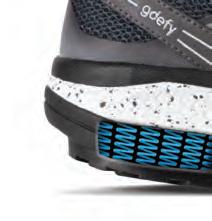

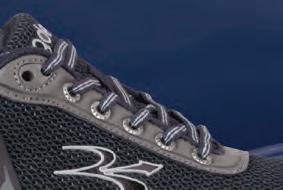











– Bill F.



























































